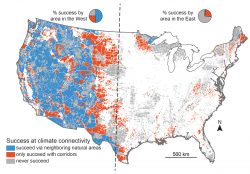
Western areas of the U.S. provide greater temperature ranges and fewer human interruptions than eastern landscapes, allowing plants and animals there to move toward more hospitable climates with fewer obstacles. A new study has found that only 2 percent of the eastern U.S. provides the kind of climate connectivity required by species that will likely need to migrate under climate change, compared to 51 percent of the western United States.
The research, reported June 13 in the Proceedings of the National Academy of Sciences, for the first time quantifies the concept of climate connectivity in the United States. The paper suggests that creating climate-specific corridors between natural areas could improve that connectivity to as much as 65 percent nationwide, boosting the chances of survival by more species. The issue is especially critical in the Southeast, which could provide routes to cooler northern climates as temperatures rise.
McGuire, a former postdoctoral researcher at the University of Washington, focused on this project while working with co-author Joshua Lawler, a UW professor of environmental and forest sciences.
Read more at UW Today »
